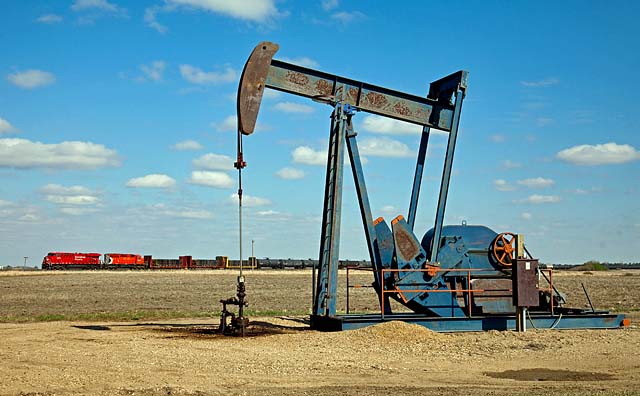
2012
|


A trainload of oil travels along Canadian Pacific's Portal Subdivision near Flaxton, North Dakota, USA -
25 Apr 2012 Steven M. Welch.
17 September 2012
Rail Gains Steam as a Crude Oil Mover
Canada - Canada's oil patch is quietly sending large new volumes of oil on rail cars, even as it fights to overcome mounting opposition
to plans for new pipelines to the U.S. Gulf Coast and Canada's West Coast.
Though solid numbers are not available, industry sources say upward of 80,000 barrels a day of Canadian oil is now moving to market on rail cars. It's a small
fraction of the 2.3 million barrels a day the country exports, overwhelmingly by pipeline. But rail is rising fast: last year at this time, some 5,000
barrels a day left Alberta on trains. By next year, executives, oil producers, and energy traders estimate it will exceed 200,000 barrels a day.
The rise of rail comes as the industry scrambles to gain better prices for Canadian oil, which has suffered deep discounts because of overstuffed pipelines and
over-supplied U.S. Midwest markets. A new pipeline takes years to build, but with rail, an oil company can send product to new markets in days with portable
train-loading equipment. The new destinations that companies are now accessing, the Gulf Coast, U.S. Northeast, California, and Central and Eastern Canada,
offer better prices that are directly boosting profits in Alberta.
But the speed of industry's embrace of rail, which is set to move as much next year as a mid-sized pipeline, also suggests a much broader shift is under way.
As more oil moves on trains, it stands to supplant the need for new pipelines, whose construction has grown increasingly difficult.
The motivation for moving by rail is clear. Depending on the day, companies can fetch between US$10 and US$30 more per barrel by selling their oil in new
markets, especially along the coasts where it receives a higher international price.
Trains stand to be a permanent, rather than temporary, option for the oil patch.
It's a likelihood even Enbridge Inc., the largest carrier of Canadian oil by pipeline, has acknowledged, saying that at least 10 percent of domestic crude,
perhaps as much as a quarter, could move by rail by 2035. Without rail, Enbridge warns, either major new pipelines will have to be built, or "the
alternative for the Western Canadian crude producers is shut-in."
The Enbridge analysis is conservative, suggesting rail won't pick up significant volumes until 2018. But that has already begun, and is set to pick up
substantially next year.
Canadian National Railway alone has increased its number of loading sites to 14 from three. CN expects to average nearly 50,000 barrels a day of oil in rail
cars this year. Competitor Canadian Pacific Railway recently boosted its forecast to over 100,000 barrels a day next year, a quantity it originally expected to
hit in 2014, although much of that is U.S. oil from North Dakota. "It is developing very quickly," said Tracy Robinson, a vice-president at CP, who
believes "there is a permanent place for rail in the crude market."
In the U.S., rail is moving at a breakneck pace. BNSF Railway said earlier this month it has the capacity to move a million barrels a day out of the Bakken
play in Montana and North Dakota. Some of that is coming back into Canada, as a broad range of producers and refiners join the rail ranks. Rail also offers the
possibility of international exports that don't need new pipelines such as Northern Gateway. Some companies, for example, have begun examining exports to
Europe through Atlantic Canada ports accessible by rail.
At the same time, the price disadvantage of rail is diminishing.
"The cost of rail versus pipe isn't hugely significant these days, especially now with the increased regulations and delays on pipelining," said
Crescent Point Energy Corp. chief executive officer Scott Saxberg. "We see it being in the $2 a barrel range."
Nathan Vancrklippe.

|


|
Vancouver Island
British Columbia
Canada
|
|

